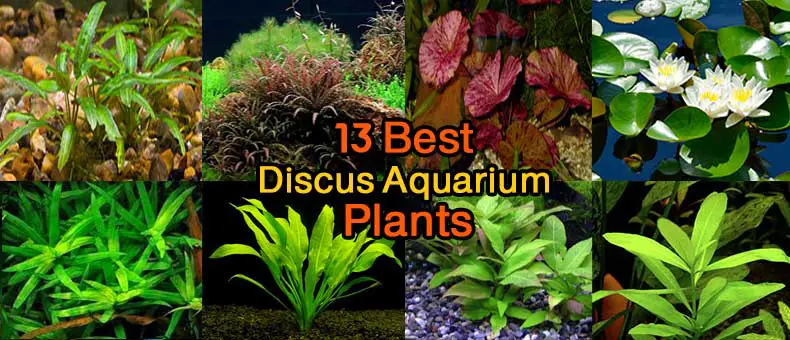
When considering how to set up a planted Discus tank, most breeders tend to compromise the temperature of the tank, keeping Discus fishes at a temperature that’s a bit low but a bit high for plants, however, this is not a good practice for the health of your Discus, instead, you should consider selecting pants that are fully compatible with your Discus environment requirements.
Some suitable plants for discus tanks are listed below.
Table of Contents
- What Kind Of Plants Do Discus Fish Like?
- 13 Best Discus Aquarium Plants List
- How Do You Keep Discus In A Planted Tank?
- Conclusion
What Kind Of Plants Do Discus Fish Like?
Discus fishes like plants with leaves that are either tall or broad so that they can act as protection or cover for when the fishes feel threatened. There are many Discus aquarium plants for sale and the list below contains the best floating plants for Discus.
13 Best Discus Aquarium Plants List
[1] – Anubias Nana
The leaves of this plant are slightly broad, wide, round, and green in color.
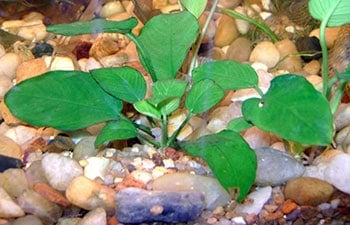
Furthermore, the broad leaves provide a surface of spawning for Discus fishes.
The maximum height that the Anubias nana can grow is 7.5in; however, they are not fast-growing plants so it is not out of place to place them in a small tank especially if you’re just starting out as a Discus keeper.
Anubias nana has rhizomes and therefore it can be put into gravel substrate, suppose that is your preference. Be that as it may, they are better off when tied to driftwood or rocks. By the way, sand and gravel for the discus tank make the best substrate for Discus.
Anubias Nana Requirements
- The water temperature requirement for Anubias nana is between 72º – 82º F.
- The pH level of 6.0 and 7.5.
- Water hardness between 3 and 8 dGH.
It can survive with low light or even in areas covered with shade within the tank.
Buy Anubias Nana at an affordable price.
[2] – Java Fern
Java fern is a plant that has long thin and pointed leaves that makes it look like it combines tall grass with some leaves.
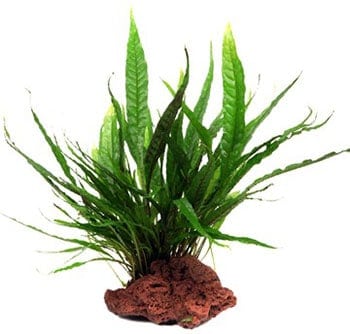
The growth rate of the Java fern plant is between slow and moderate.
The maximum height that the plant can grow into is 14 inches such that it forms a sort of leaf-like wall, providing Discus fishes with a place of comfort, privacy, and serves as a sanctuary for when the fishes sense danger. Discus fishes can also spawn on the Java fern.
This plant does not require much attention so regular tending is not necessary, while it is true that it grows to be very tall, you might only need to trim down the leaves when your aquarium or tank is small.
You may check the affordable price and buy Java Fern.
Java Fern Requirements
- Water temperature between 68º and 82º F.
- The pH level of 6.0 to 7.5.
- A level of water hardness between 3 and 8 dGH is what’s suitable for this plant.
[3] – Jungle Vallisneria
Jungle Vallisneria looks like a very long and large grass whose leaves are of a regular size and at the end are pointed.
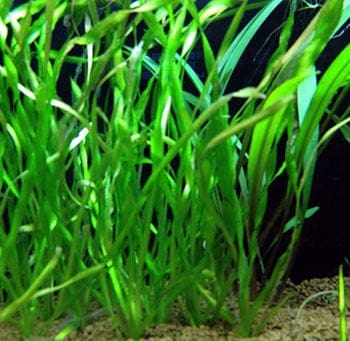
If you don’t know it, you could easily mistake it for a normal long grass in the field. Nevertheless, it is able to grow to about 6 feet or 2 meters in height.
In a small Discus aquarium tank, it will be better as a background plant or a midground plant if you have a large-sized tank.
Jungle Vallisneria is an ideal plant for discus fish since the grasses create a thick wall for Discus to hide and spawn.
Jungle Vallisneria Requirements
- Water temperature between 62º and 82º F
- The pH level of 6.0 and 9.0.
- Water hardness level between 6 and 9 dGH.
The plant can withstand the high temperature and water conditions that Discus fishes live in.
You can check the price list and buy Jungle Vallisneria.
[4] – Brazilian Pennywort
The Brazilian Pennywort has thin green stems with round leaves on its stems.
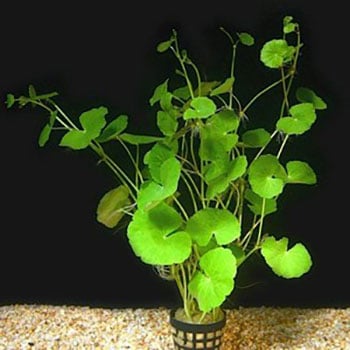
The amazing thing is that the plant has roots, but it can also be a floating plant. The roots can be placed in the substrate and the plant will grow, still, they can be tied to driftwood or rocks or even allowed to float on the water thus giving Discus fish plenty of covers.
Brazilian Pennywort Requirements
- Water temperature between 68º and 82º F.
- The pH level of 6.0 and 7.8
- Water hardness between 3 and 18 dGH.
The growth rate of the plant is moderate and it will grow continually under good lighting. It is recommended that you trim the plant if your tank is small.
I recommend you check its affordable price and buy the Brazilian Pennywort plant.
[5] – Phyllanthus Fluitans (Red Root Floater)
Phyllanthus fluitans is another floating plant, part of the family, Phyllanthaceae.
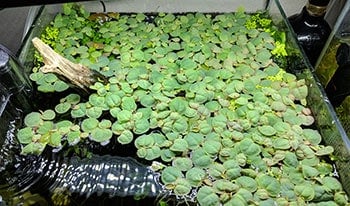
It has round leaves that tend to repel water and could turn brown-red in color if there is little supply of nitrogen and the lighting in the tank is too high. The roots of this plant are also red in color which affords it the name ‘Red root floater’.

Moreover, it is not hard to grow and maintain the Phyllanthus fluitans, all you need is good lighting and make sure that the water is rich in nutrients. It branches and breaks its thin, soft stems in order to propagate.
Phyllantus Fluitans Requirements
- Water temperature between 70º and 82º F.
- The pH level of 6.5 and 7.5.
- Water hardness level between 0 and 30 dGH.
[6] – Amazon Sword
The Amazon sword plant has very large, wide, long, and broad leaves.
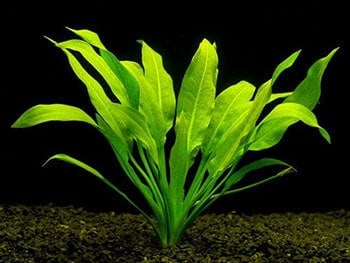
Each of the leaves looks like a small sword hence the name ‘Amazon sword’. Because of the nature of the leaves, they make for good places where Discus fishes can hide and lay eggs.
Amazon Sword is a root plant and it requires a good substrate to grow. So, make sure the soil in the tank is fertile and also ensure that the plant gets moderate or bright light.
Amazon Sword Requirements
- Water temperature requirements between 60º and 84º F.
- The pH level between 6.5 and 7.5.
- Water hardness between 8 and 15 dGH.
The plant can grow up to 16 inches in height which makes it good as a background plant in small tanks and in a larger fish tank, it is more suitable as a midground plant.
Amazon Sword is available at Amazon at affordable prices you much check it and buy it from here.
[7] – African Bolbitis
The African Bolbitus is also a fern, however, it is important that is why it is on this list.
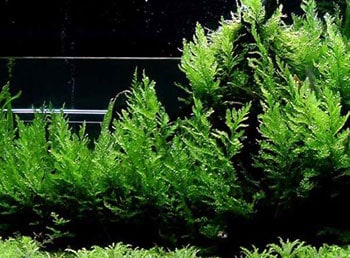
It is sometimes called African Water Fern and some of its features are alike with the Java Ferns. It is a plant with a slow growth rate and for it to grow, it has to be put inside wood or rock.
You can easily find the plant in areas where the water moves fast and in rivers and streams that are covered with shade.
The plant is not difficult to keep and maintain. It does not need a light that is too bright, any additional fertilizer, or injected CO2. It can be a good plant for starting a new tank but it can also be kept in a much larger aquarium.
African Bolbitus Requirements
- Water temperature requirements between 68º and 82.4º F.
- The pH level between 6 and 8.5.
- Water hardness between 4 and 12 dGH.
You may order African Bolbitis plants online from Amazon.
[8] – Cryptocoryne
Cryptocoryne plants are of numerous varieties, each and every variety is ornamental and is perfect to be buried in the substrate of any aquarium.
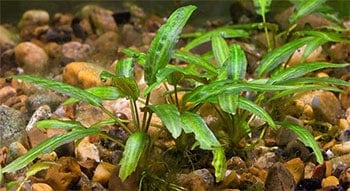
They thrive on aquarium soil that is rich in nutrients, however, their roots can also be put into rocks and wood and they will still grow. These plants propagate very quickly and require a moderate amount of lighting.
You need a lot of crypt varieties for your planted Discus aquarium since they provide an ornamental and yet sturdy appearance.
Cryptocoryne Requirements
- Water temperature between 72º and 82º F.
- The pH level of 5.5 to 7.5.
- Water hardness level between 1 and 20 dGH.
Order Cryptocoryne plants online at an affordable price.
[9] – Bucephalandra
This plant is sturdy and it can be useful when it comes to giving your discus aquarium a feel of importance and attraction.
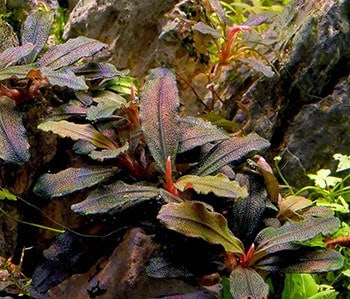
Bucephalandra has varying shapes and sizes, be that as it may, the high temperature required by discus fishes do not affect them.
The plant grows slowly, it has thick leaves, and it is capable of being rooted anywhere within the tank or aquarium because it takes its nutrients from the water comb. For foreground plants, the smaller ones are recommended.
Bucephalandra Requirements
- Water temperature between 71º and 82.5º F.
- The pH level of 6 to 7.5.
- Water hardness between 3 and 12 dGH.
They do however thrive under low lighting so it is best to have stayed in the dark areas within your aquarium.
[10] – Hygrophila
The varieties of this plant include Hygrophila polysperma (Dwarf Hygro), Hygrophila corymbose (Temple plant), and Hygrophila Pinnatifida are good plants for a Discus aquarium.
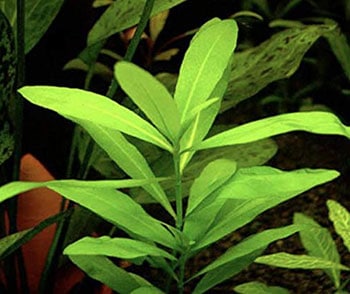
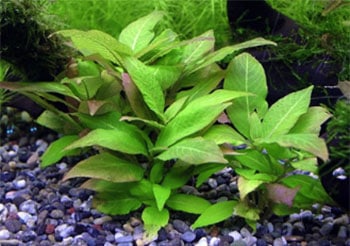
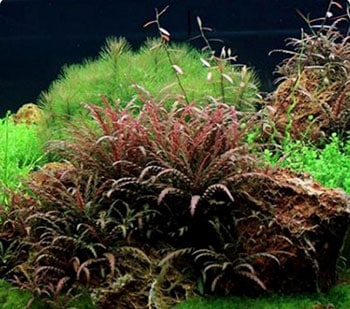
Though the downside of Hygrophila is that, the listed varieties are the hardest to maintain.
The Hygrophila plant is capable of enduring a wide range of water situations and the plant is even sturdy so the high temperature of the water which is required by Discus will not affect the plant. It is another one of the fast-growing plants out there.
Hygrophila Plants that grow fast require a lot more nutrients than plants whose growth rate is slow and to help them grow, you need to add liquid fertilizer to the water.
Hygrophila Requirements
- Water temperature between 64º and 86º F.
- The pH level of 6 to 7.5.
- Water hardness between 4 and 18 dGH.
If you allow the leaves to float on the surface of the tanks they will transform into new plants. It is a stem plant, although new shoots tend to form along with the stem and thus, it can look tangled and bushy which is one thing to look out for when aquascaping a Discus aquarium tank with Hygrophila.
Order Hygrophila plant online.
[11] – Dwarf Tiger Lily
The Dwarf Tiger Lily is a plant with a bulb that has red leaves.

It raises its stem to the surface of the water once in a while in order to grow lily pads and flowers and it is a very good plant for a Discus tank.
Dwarf Tiger Lily adds an ornamental substance to your Discus aquarium or tank.
The plant is sturdy enough to survive the high-water temperature which Discus fishes live in. One thing is that they require being watched regularly; their roots are able to spread quickly in the substrate so if you are not careful you may find them scattered all around the tank.
Dwarf Tiger Lily Requirements
- Water temperature between 72 and 820 F.
- The pH level of 5.5 to 7.5.
- Water hardness between 3 and 18 dGH.
[12] – Spatterdock
This plant is a water lily and they can be found in ponds.
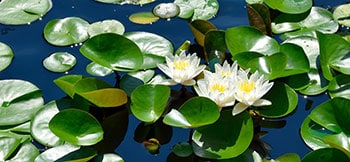
You should consider growing them when aquascaping your Discus tank. This particular lily plant is capable of growing an enormous amount of leaves underwater before it shoots up and begins to create pads over the water surface.
The plant feeds through its roots and so a nutritious soil or additional root tab fertilizer is needed to grow it.
Spatterdock Requirements
- Water temperature between 65 and 850 F.
- The pH level of 6.5 – 8.0.
- Water hardness between 3 and 18 dGH.
[13] – Heteranthera
Heteranthera is one plant that is compatible with a Discus aquarium and yet grows very fast unlike a lot of the others.

It has a lot of branches at the sides and thus, the plant tends to look bushy quickly.
The stem of the plant is able to grow to about 15 inches or even more than that, however, it is important that you trim the plant as soon as possible because the plant needs a good amount of lighting and you would do well to make sure that the leaves at the bottom get a feel of the light.
Heteranthera Requirements
- Water temperature between 68 and 820 F.
- The pH level of 6.0 – 8.0.
- Water hardness between 4 and 18 dGH.
How Do You Keep Discus In A Planted Tank?
To keep Discus fishes in a planted tank, make sure both the plants and Discus are compatible and the plants can survive the water conditions of the tank, the plants must also have broad leaves so they provide cover for when discus wants to hide or spawn.
Conclusion
When setting up a planted Discus tank, you need to consider the following; are the plants the best aquarium plants for warm water or the best floating plants for Discus? what is the best substrate for discus? whether to use sand or gravel for a discus tank?. Answering these questions will help you figure out the best Discus aquarium plants.

